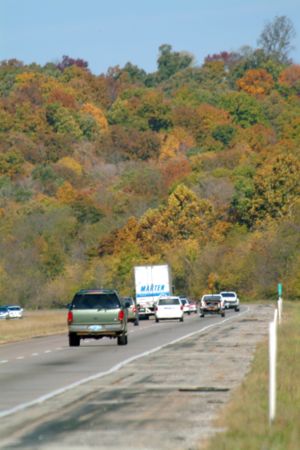Shoulder Surface
Paved shoulders and aggregate stabilized shoulders provide a secure surface to accomodate vehicles for emergencies and other uses. Paved shoulders are an integral part of the pavement structure and are considered as part of the pavement design configuration. See Shoulder Width for additional information
Shoulders on urban roadways with access control (major or minor) are to be paved. In no case will a paved or aggregate surface be used directly behind a mountable curb along the outer edge of a roadway. A curb and gutter will only be used with an anticipated posted speed less than 50 mph.
Currently shoulder designs are categorized as A1, A2 and A3.
Type A1 shoulder design is comprised of asphalt or concrete on a prepared aggregate subgrade placed the same thickness as the mainline pavement. This shoulder type should be used sparingly, in instances that can be justified such as where there is an imminent need for use of the shoulder as a lane.
Type A2 shoulder design consists of asphalt, concrete or roller compacted concrete on a prepared aggregate subgrade with the final surface placed 5 ¾ in. thick. This shoulder should be used on all interstate routes and for major roadways with significant traffic.
Type A3 shoulder design consists of asphalt, concrete, or roller compacted concrete on a prepared aggregate subgrade with the final surface placed either 3 ¾ in. thick (asphalt) or 4 in. thick (concrete or roller compacted concrete). This shoulder should be used on major routes with relatively lower traffic volumes and on minor routes where a paved shoulder will be provided.
Where a paved shoulder is provided on major routes, the full thickness of the travel way pavement should be extended laterally to a longitudinal joint either 1 ft. or 2 ft. outside the travel way. This widening should extend 2 ft. for interstate and 1 ft. for all other locations. In instances where short segments of pavement are placed, butted at each end by pavement that is not widened, approval may be obtained to omit the widening.
Ramp shoulders should be consistent with the mainline. For ramps with integral curbs, the shoulder material and thickness will be specified in the pavement thickness determination.
Minor road shoulders should be aggregate stabilized except when maintenance or safety concerns (e.g., edge drop off, high run-off road occurrence) justify an alternate treatment. When conditions warrant, a 1 or 2 ft. lateral extension of the mainline pavement should be considered as an initial option. If paving the remaining width of shoulder is justified, the shoulder should consist of the Type A3 shoulder design.
